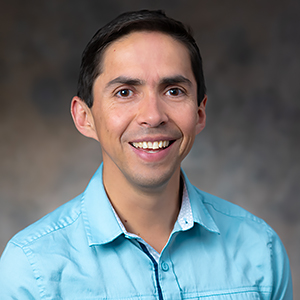
Santiago Toledo Associate Professor CAS | CHEM | Chemistry
- Degrees
- PhD, Chemistry, University of Washington - Seattle;
BS, Chemistry, Texas Lutheran University - Bio
- Dr. Toledo is a bioinorganic chemist with a passion to uncover the role that metals play in biological systems. His research team focuses on two main themes: a. the synthesis and reactivity of biomimetic models of metalloenzymes with the goal of understanding the role that metalloenzymes play in disease states including cancer development and neurodegenerative diseases. b. the design of bioinspired catalysts to promote challenging oxidative transformations for use on environmentally relevant degradation of organic compounds. The Toledo lab uses a variety of synthetic (organic and inorganic), and spectroscopic tools to characterize and understand these novel bioinspired inorganic complexes. Dr. Toledo is also passionate about student learning. He is interested in course design structures that promote equitable and inclusive learning environments. His work focuses on the use of clearly delineated student learning outcomes built around taxonomies of learning. Additionally, he has done extensive work on alternative grading methodologies including standards and SPECS based grading. Dr. Toledo consults with colleagues nationally and internationally on these matters. Dr. Toledo obtained his Ph.D. from the University of Washington, Seattle, under the supervision of Dr. Julie Kovacs. He graduated with a B.S. in Chemistry from Texas Lutheran University, where he worked under Dr. John McClusky. Dr. Toledo has worked in the academy for over 15 years initially in his alma matter, Texas Lutheran University. He then moved to St. Edward’s University where he served as Department Chair from 2019-2022. He is a native of Quito, Ecuador, he loves running, hiking, fútbol and his amazing family.
- For the Media
- To request an interview for a news story, call AU Communications at 202-885-5950 or submit a request.
Teaching
Fall 2024
-
CHEM-110 General Chemistry I
-
CHEM-110 General Chemistry I
Spring 2025
-
CHEM-210 General Chemistry II
-
CHEM-450 Bioinorganic Chemistry
Partnerships & Affiliations
-
Delaware INBRE
External Advisory Committee Member -
Division of Inorganic Chemistry
Awards Committee Co-Chair
Scholarly, Creative & Professional Activities
Selected Publications
Kirsch, K; Little, M. E.; Cundari, T.R.; El-Shaer, E.; Barone, G.; Lynch, V. M.; Toledo, S.A.* Direct O2 mediated oxidation of a Ni(ii)N3O structural model complex for the active site of nickel acireductone dioxygenase (Ni-ARD): characterization, biomimetic reactivity, and enzymatic implications. Dalton Transactions, 2024, https://doi.org/10.1039/D4DT02538E.
Toledo, S.; Yan Poon, P.C.; Gleaves, M.; Rees, J. Rogers, D. Kaminsky, W.; Kovacs, J. Increasing Reactivity by Incorporating π-Acceptor Ligands into Coordinatively Unsaturated Thiolate-Ligated Iron(II) Complexes. Inorganica Chimica Acta, 2021, 524,120422. https://doi.org/10.1016/j.ica.2021.120422
Blade, G.A. †; Parveen, R.; Jaimes, J.L. †; Ilustre, W. †; Saldaña,D. †; Ivan, D.A. †; Lynch,V.M. Cundari, T.R.; Toledo,S.*A family of structural and functional models for the active site of a unique dioxygenase: Acireductone dioxygenase (ARD). Journal of Inorganic Biochemistry, 2020, 212, 111253. https://doi.org/10.1016/j.jinorgbio.2020.111253
Healy, E. F.; Flores, R.†; Lynch, V.M.; Toledo, S.*Protein dynamics of [CuZn]superoxide dismutase (SOD1): How protein motions at the global and local levels impact the reactivity of SOD1. Journal of Inorganic Biochemistry, 2020, 210, 111161. https://doi.org/10.1016/j.jinorgbio.2020.111161
Healy, E.; Roth-Rodriguez, A. †; Toledo, S.A model for gain of function in superoxide dismutase. Biochemistry and Biophysics Reports. 2020, 21, 100728. https://doi.org/10.1016/j.bbrep.2020.100728
Toledo, S.A.*; Dubas, J.M. A Learner-Centered Grading Method Focuses on Reaching Proficiency with Course Learning Outcomes. Journal of Chemical Education, 2017, 94, 1043-1050. https://doi.org/10.1021/acs.jchemed.6b00651
Toledo, S.A.*; Dubas, J.M. Encouraging Higher-Order Thinking in General Chemistry by Scaffolding Student Learning Using Marzano's Taxonomy. Journal of Chemical Education, 2016, 93, 64-69. https://doi.org/10.1021/acs.jchemed.5b00184
Research Interests
- Bioinorganic chemistry
- Bioinspired catalysis
- Coordination Chemistry
- Chemical education on equitable and inclusive practices
- Taxonomies of learning
- Alternative grading methodologies
